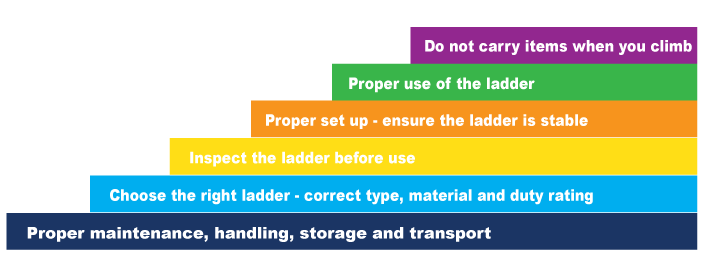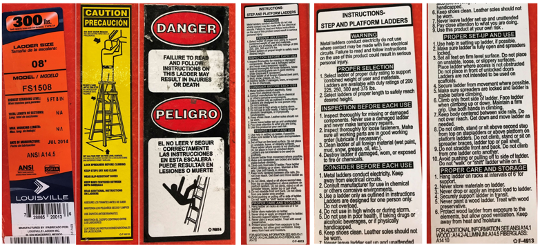By Pat Donovan, Northcentral Construction
On average, 149 workers died each year because of falls from ladders from 2011-2019. In that same period, an average of 2,510 non-fatal injuries occurred. These staggering statistics have continued to hold true since 2019. Roughly 80% of ER visits from falls involved ladders and 43% of deaths involved ladders.
We all strive to provide the safest work environment possible for our team members so that they can go home to their loved ones each night while accomplishing the necessary work. Employees are a company’s most valuable resource and failing to train them on proper ladder use, or failure to enforce proper use is unacceptable. Not only does this take a team member out of service, causing reduced production on the job there are monetary costs. A 2019 study determined the average cost of a non-fatal fall to be $41,000 per employee and the total cost to companies that year was over $2.5 million dollars.
Safe and Efficient use of ladders is not complicated or difficult, but it does require that users learn and practice proper ladder safety habits.
In FY 2020 OSHA reported 2,127 ladder citations. The top five violations were:
- Not extending the ladder three feet above the surface.
- Using ladders for a purpose other than what they are designed for.
- Using the top step or top of the ladder.
- Failure to tag ladders with defects and take them out of service.
- Improper setup of ladders – not having a one-to-four angle.
Ladders are a unique area on our jobsites in that almost every job has them on site and there are no fall protection requirements while using them. The safety on ladders is a combination of good maintenance, proper setup, and safe use practices. There are many different types of ladders, and each has nuances to the proper setup and use. The graphic below shows the steps that are common to all ladders.

Proper maintenance includes cleaning ladders to ensure they are free of oil, paint or other slippery materials. In requires protecting the ladder from excessive wear and tear from the weather, heat and cold. You need to store and transport ladders in a manner that prevents damaging them.
Choosing the right ladder involves answering some basic questions.
- Can I lean the ladder, or does it need to be free standing?
- How high do I need to reach?
- Am I working around electricity?
- How much total combined weight must be supported.
If working near electricity you will want to use a fiberglass ladder. Remember electric can jump from the source to a conductor up to 43” depending on the voltage.
If you are leaning then you will be looking for a straight ladder, extension ladder or hybrid step ladder. The height that needs to be reached drives the length or height of the ladder. Next, when looking at weight, remember to consider your weight plus the weight of your tools and material. Ladder duty ratings are as follows:

Next you must inspect your ladder to make sure there is no damage and that it is working properly. You are looking for cracks, splits, broken or missing parts, food pad condition, bolts and proper working order. All labels must be visible and readable as they convey proper setup, use and safety instructions. The images shows examples of the labels found on ladders.

Proper setup and use of ladders involves some common steps and some specific to the ladder model. It would be impossible to cover every situation. The following are some of the basic the steps for the two most common ladders:
Always maintain three points of contact when climbing ladders. Never work higher than the safe working height.
Step ladders:
- Check the area to make sure you are clear of electrical lines or other overhead lines.
- Ensure you have a solid level non slippery surface.
- The ladder needs to be fully opened with both spreader bars locked in place.
- If working near doors or high traffic areas secure your work area.
- When working your torso should remain between the ladder rails.
- You should always work facing the ladder.
- Do not use the top step or the top of the ladder as a step.
- Do not walk a ladder always climb down and reposition the ladder.
- Remove tools for the ladder when repositioning it.
Extension ladders, straight ladders and hybrid step ladders used as straight ladders.
- Check the area to make sure you are clear of electrical lines or other overhead lines.
- Ensure you have a solid level non slippery surface.
- Place the ladder so that the fly section is facing out.
- Place the ladder so that the base is 1’ from the vertical surface for every 4’ in height to where the ladder will touch the wall or to the top of the wall if accessing another level.
- Raise the fly section to the highest level needed and both rung locks are in place.
- Brace the bottom of the ladder to prevent the feet from sliding out or have someone hold it.
- Make sure both top caps or top contact points are resting securely against the surface and that you have at least 12” of surface to both sides of the ladder.
- If accessing another level or roof:
- Make sure that the ladder extends three feet above that level.
- Secure the ladder at top to prevent it from shifting or sliding.
- When working your torso should remain between the ladder rails.
- You should always work facing the ladder.
- Do not use the top step or the top of the ladder as a step.
- Do not walk a ladder always climb down and reposition the ladder.
- Do not reposition the ladder from the upper surface.
- Do not carry materials or tools while climbing the ladder. If necessary, use a rope to bring tools up to you once in place.
I want to stress that this is the bare minimum information you should be aware of when dealing with ladders. It is imperative that you avail yourself of the many opportunities there are to further your understanding of the proper steps to take to ensure you are safe when using ladders. Several good free resources for additional training are
There are many more resources available, and it is important that as skilled trade professionals, and employers or those professionals, that we do not take ladder safety for granted. Remember at the end of the day it is your responsibility to take the steps to ladder safety.














